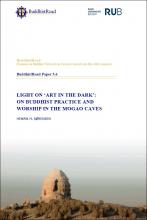BuddhistRoadPaper 5.6 "Light on ‘Art in the Dark’: On Buddhist Practice and Worship in the Mogao Caves"
Synopsis
This piece has partly been written in response to a series of claims put forward by Robert Sharf almost a decade ago in his article Art in the Dark in which he argues that the Buddhist caves in Dunhuang (and elsewhere in China and Central Asia) were not for worship, but were created as a sort of ancestral memorials, or decorated mausoleums meant to be left in the dark. Given that the implications of such reading of Buddhist cave-art in the Sinitic cultural-sphere would surely have a profound impact on our overall understanding of Buddhist ritual practices and cave-art, should Sharf’s readings turn out to be correct, the evidence and speculations he uses as underpinnings for his line of argument in particular merit closer scrutiny. Moreover, as he touches upon a range of other related issues, all of which concern Buddhist ritual practices one way or another, it seems worthwhile to devote a lengthier essay to a more detailed discussion.
Chinese Translation
本文部分是为了回应Robert Sharf近十年前在《黑暗中的艺术》一文中提出的一系列主张, 他认为敦煌 (以及中国和中亚的其他地方) 的佛教石窟并非用于崇拜, 而是作为一种祭奠祖先之处或装饰的陵墓, 旨在被留在黑暗中. 如果Sharf的解读是正确的, 那么, 他对汉文化圈佛教石窟艺术的这种解读, 肯定会对我们对佛教仪式实践和石窟艺术的整体理解产生深远的影响, 他用来作为论证基础的证据和推测尤其值得仔细研究. 此外, 由于他触及了一系列其他相关的议题, 而这些议题又都以某种方式涉及到佛教的仪式实践, 因此似乎值得用更长的文章来进行更详细的讨论.

Downloads
Published
Categories
License

This work is licensed under a Creative Commons Attribution-NonCommercial-NoDerivatives 4.0 International License.

